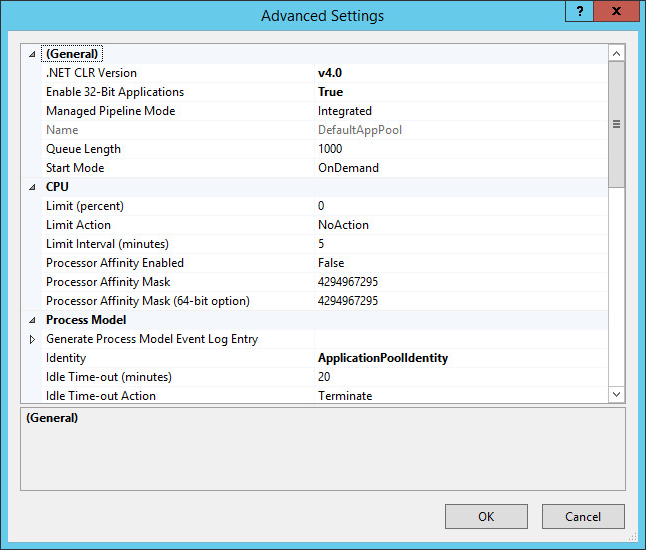Windows Server 2012 R2, Windows Server 2016 and Windows Server 2019 (US English) (Language packs are supported) running as a standalone IIS 7.0 server with the Web Server (IIS) Role installed
The Role Services that are needed can be installed by selecting the role using the following commands
Windows Server 2012 R2 Command:
Install-WindowsFeature AS-NET-Framework, RSAT-ADDS, Web-Server, Web-Basic-Auth, Web-Asp-Net45, Web-Windows-Auth, Web-Metabase, Web-Net-Ext45, WAS-Process-Model, Web-ISAPI-Ext, Web-Digest-Auth, Web-Dyn-Compression, NET-HTTP-Activation, RPC-Over-HTTP-Proxy –Restart
Windows Server 2016 and Windows Server 2019 Command:
Install-WindowsFeature RSAT-ADDS, Web-Server, Web-Basic-Auth, Web-Asp-Net45, Web-Windows-Auth, Web-Metabase, Web-Net-Ext45, Web-Lgcy-Mgmt-Console, WAS-Process-Model, Web-ISAPI-Ext, Web-Digest-Auth, Web-Dyn-Compression, NET-HTTP-Activation, RPC-Over-HTTP-Proxy –Restart
You can run these commands from the PowerShell window, which is a part of the Windows Server.
Windows Installer 4.5 or higher
.NET 4.8
Once the install completes, each of the three Binary Tree IIS applications (Autodiscover, AvailabilityService, and BTRouter) needs to be configured to use a .Net 4.0 application pool.
This can be set via the Advanced Settings for the DefaultAppPool in IIS; change Application Pool to ASP.NET v4.0. For further clarification, below is a screen shot of the setting:

SSL Certificate with the hostname of the server, fully qualified domain name of the server, and the Autodiscover host name(s) representing the Domino environment (i.e. autodiscover.domino.contoso.com), as its subject or subject alternative name (SAN) must be installed
PKI Domain sign certificate can be used for on-premises implementation of Office 365. Office 365 implementation requires a third-party certificate
IIS PowerShell Snap-In (x64) (already installed on the server when using Windows Server 2012 R2 or higher)
The Windows Coexistence Server cannot have Exchange installed on it
Free/Busy will only be supported on a standalone Windows Coexistence Server
The requirements for Directory Sync Pro must be met if Directory Sync Pro components are to be installed on the Integration for Notes BTCal infrastructure. Refer to the Directory Sync Pro Requirements document for more information.
Integration for Notes BTCal requires a license supplied by Quest.
All Domino mail files should use a standard Notes template, currently supported by HCL; modifications to the standard mail templates can result in unexpected behavior in messaging, calendaring or application remediation, and should be validated before deploying Integration for Notes BTCal in production environments
All Domino Servers need to be at release level currently supported by HCL:
Users on Domino Mail Server prior to release level 6.0.3 will experience issues receiving iCalendar (calendaring) data from Microsoft Exchange
All Domino entries to be synchronized into Exchange must have valid and unique SMTP addresses in the Domino Directory; this includes people, groups, mail-in databases, and rooms and resources
At least one Microsoft Exchange Server version 2013 or higher with Send and Receive Connectors configured for communication with Domino
All Microsoft Outlook clients are version 2013 or higher; Outlook 2003 clients will NOT be able to access Free/Busy information for Domino users and Outlook 2007 is no longer supported
At least one end-user workstation with Lotus Notes Client (version 8.x or higher), and one end-user workstation with Microsoft Outlook Client (version 2013 or higher) should be available to represent end-users; these workstations may run on physical or virtual machines
All components of Integration for Notes BTCal are fully functional on physical as well as virtual machines. When setting up Proof of Concept or Pilot coexistence environments, Binary Tree fully supports, in fact, recommends the use of virtual machines as a means of lowering the expense of such projects. However, when it comes to production coexistence environments, Binary Tree has not yet gathered sufficient information to determine whether virtual environments have the same stability and performance characteristics as physical machines. Because a majority of production coexistence environments have been and are deployed on physical machines, Quest advises potential customers of these facts, but defers to them to make the final decision. Quest will provide product support in both physical and virtual environments; however, if either stability or performance issues are found in a virtual environment, Quest may recommend switching to a physical one as a means of issue correction.
The Microsoft Exchange and Domino Servers must be connected via a LAN (10 Mbps or higher) connection; a high-speed WAN (5 Mbps or higher) connection may be acceptable but is not recommended. Where possible, it is recommended to have the Exchange and Domino servers as well as the Binary Tree migration workstations on the same physical network.
Characters with diacritics (é, ü, etc.) are supported, but NOTES.INI must be in UTF-8 format without a BOM. Notepad++ is the recommended tool for saving in this format; UTF-8 format that includes the BOM, or byte order mark cannot be read.
A SAN Certificate for the FreeBusy Name space if secure connections are to be enabled.
TLS 1.2 is required to ensure SSL security.
DNS CNAME record for Autodiscover for the FreeBusy Name space (e.g. autodiscover.domino.yourSMTPdomain.com).
Network access to the Domino Coexistence server for SMTP mail routing (Port 25). This can be limited to Microsoft’s public IP ranges for Office 365 deployments.
Network access to the Windows Coexistence server for FreeBusy processing (Ports 80 and 443). This can be limited to Microsoft’s public IP ranges for Office 365 deployments.
To deploy Integration for Notes Free/Busy on the Windows Coexistence Server, an Active Directory account with Server Administration rights must be able to log on to the server interactively. The account must be able to run programs with Administration-level access on the target Exchange Server and specifically be able to open the Exchange Management Shell (PowerShell).
The BT FreeBusy application will require an account to access Exchange or Office 365 Scheduling data.
Administrative rights to Exchange or Office 365
Exchange or Office 365 access account (e.g. BtFreeBusy@yourSMTPdomain.com or BTFreeBusy@tenant.onmicrosoft.com)
Member of local administrators group